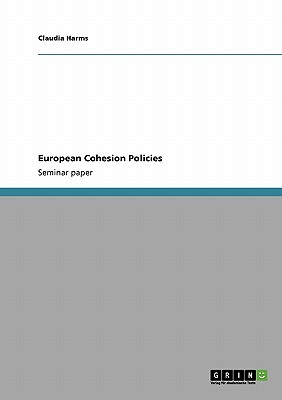
- We will send in 10–14 business days.
- Author: Claudia Harms
- Publisher: GRIN Verlag
- ISBN-10: 3640256913
- ISBN-13: 9783640256914
- Format: 14.8 x 21 x 0.4 cm, softcover
- Language: English
- SAVE -10% with code: EXTRA
Reviews
Description
Seminar paper from the year 2008 in the subject Politics - International Politics - Topic: European Union, grade: 1,3, Berlin School of Economics and Law, course: Modul: Europäische Kohäsionspolitiken und Förderinstrumente, language: English, abstract: Cohesion policies are a mean to support European integration. This esay indicates the main financial instruments which are to achieve cohesion. It identifies crucial factors leading to successful implementation of European funding programmes. The essay addresses the following issues: 1. Analysis of the relationship between the two objectives of the cohesion policies, growth and reduction of disparities. Are there any contradictions or tension between these objectives or do they just complement each other? 2. Analysis and comparison of the priorities of the European Regional Development Fund (ERDF) and the European Social Fund (ESF) in the light of the overall objectives for the cohesion policies. What are their differences in scope? Where are similarities? Where are potential synergies? 3. For the funding period 2007-2013 the budget of the European Structural Funds is dedicated to certain objectives and financial instruments. How is the present distribution of the financial means of the Structural Funds? What are the main reasons and criteria having guided the decision for this distribution? Assessment of the adequacy of the existing distribution and reasons for the conception. 4. Besides the European Structural Funds there are a large number of European funding programmes covering a broad range of thematic subjects. Systematical differentiation between sources of European funding. 5. According to a commonly agreed Operational Programme the means of the European Structural Funds are implemented decentralized by the Member States or the regions. Based on this framework, it is up the national and regional governments to make the best use of European money. How can the quality of regional public administration servic
EXTRA 10 % discount with code: EXTRA
The promotion ends in 17d.03:02:09
The discount code is valid when purchasing from 10 €. Discounts do not stack.
- Author: Claudia Harms
- Publisher: GRIN Verlag
- ISBN-10: 3640256913
- ISBN-13: 9783640256914
- Format: 14.8 x 21 x 0.4 cm, softcover
- Language: English English
Seminar paper from the year 2008 in the subject Politics - International Politics - Topic: European Union, grade: 1,3, Berlin School of Economics and Law, course: Modul: Europäische Kohäsionspolitiken und Förderinstrumente, language: English, abstract: Cohesion policies are a mean to support European integration. This esay indicates the main financial instruments which are to achieve cohesion. It identifies crucial factors leading to successful implementation of European funding programmes. The essay addresses the following issues: 1. Analysis of the relationship between the two objectives of the cohesion policies, growth and reduction of disparities. Are there any contradictions or tension between these objectives or do they just complement each other? 2. Analysis and comparison of the priorities of the European Regional Development Fund (ERDF) and the European Social Fund (ESF) in the light of the overall objectives for the cohesion policies. What are their differences in scope? Where are similarities? Where are potential synergies? 3. For the funding period 2007-2013 the budget of the European Structural Funds is dedicated to certain objectives and financial instruments. How is the present distribution of the financial means of the Structural Funds? What are the main reasons and criteria having guided the decision for this distribution? Assessment of the adequacy of the existing distribution and reasons for the conception. 4. Besides the European Structural Funds there are a large number of European funding programmes covering a broad range of thematic subjects. Systematical differentiation between sources of European funding. 5. According to a commonly agreed Operational Programme the means of the European Structural Funds are implemented decentralized by the Member States or the regions. Based on this framework, it is up the national and regional governments to make the best use of European money. How can the quality of regional public administration servic


Reviews